
Wolfgang Holzel was yet another lost opportunity for Australian dressage. Back then, 1984, the Australians thought all they needed was help with the ‘tricks’, and Wolfgang’s message was one that they did not wish to hear.
Wolfgang Holzel was born in 1943 and died in 1999. From 1984 to 1989 he was the Australian Dressage Coach. This article first appeared in the July 1984 edition of The Horse Magazine…
Here’s what he tried to teach the Australians back then:
Half Halts Lightness and “that good feeling”
Wolfgang Holzel is an articulate spokesman and skilled exponent of the modern Dressage Training Philosophy. A philosophy that has assimilated the theories of the Italian Cavalry officer, Frederico Caprilli, and wedded them to elements of an older Dressage Tradition, to produce the twentieth century German Training Scale.
The German Scale not only produces great Dressage horses, it can also produce great Eventers and Showjumpers… and fittingly, Dr Holzel has produced both Grand Prix Dressage Horses and A Grade Showjumpers.
Dr Holzel lives and works in the centre of riding in Germany, Warendorf, where he is in charge of the Training Centre for State Riding Instructors. Watching Wolfgang work with both horses and riders is an enlightening experience. The same principles of relaxation, encouragement and softness that he applies to the horse, are also applied to the rider. Dr Holzel will not only use his voice to soothe a horse, he is quite happy to chant his instructions to the student, reassuring with his voice and giving the rhythm as he does so. While we have become very much more sophisticated in our appreciation of the principles of training a Dressage Horse, perhaps we still have some way to go in understanding the principles of training a Dressage Rider…
It is not only Wolfgang’s knowledge, experience and teaching technique which impresses his Australian pupils, it is also the warmth of his personality and his unfeigned enthusiasm for the task at hand. He is enthusiastic about the standard of the horses he works with – and with the willingness of his pupils – to listen hard and put into practice the lessons of the previous day.
Wolfgang Holzel should put to rest forever the stereotyped image of the stern and regimented German Riding Master. Early in my notes is the observation that Wolfgang is more like one of those whimsical Irish cross country jockeys. It is only later that I learn that one of the books he has written in German, is on Hunting, and that he has hunted five seasons in Ireland.
A dinner party with Wolfgang is a hilarious affair, with much merriment and toast making. His English is extremely good, and pupils at the Clinic have no difficulty understanding him. But it was not always quite so fluent:
“Once, when I was a boy I did not know what someone says in English, I would say – ‘Yes, yes, that is right.’ Then one day I am teaching an English lady and she says something to me, and I say ‘Yes, yes, that is right’ … and she looks at me very stern! Later I think about it and work out what she has said. She has asked – ‘So you think I am too stupid to learn to ride’.”
Even judging Dressage Tests at their highest level in Germany is not without its lighter moments. Wolfgang recalls a time when he was judging with his colleague, Dr Dietmar Specht in a riding hall: “the horse and rider enter, beautiful entrance, and come to a lovely halt… one big stride to the side of the centre line! So we give him five. He does a lovely test, very precise, very good, and comes to his final halt. Lovely halt… but one stride from the centre line. We give him another five.”
“The next horse enters. Lovely entrance, and halt … and one big stride from the centre line. We give him five. Another lovely test, finished with another lovely halt … one big stride from the centre line. We mark five and jump into the arena. There is the letter… one big stride from the centre line! Of course, we have to give more points than a five… ”
As Dietmar and Wolfgang scurried to retrieve their score sheets, attendants moved the letter to the centre …
As each day passed in the school at Gert and Mary Donvig’s Statene Park, both horses and riders became more relaxed and more confident. (The value of Gert’s Dunhill Scholarship to study in Warendorf has rapidly become apparent. Within weeks of returning to Australia, Gert has arranged for both his instructors at Warendorf, Bimbo Peilicke and Wolfgang Holzel, to visit Australia and help spread the knowledge Gert gained in Germany. Both trainers are due to return to Australia for further clinics.)
Throughout the sessions, Wolfgang is impressing on the riders the importance of the half halt, and the need for the half halt to be quick, and followed immediately by the rider going soft.
“You have the half halt too long in the hands. You hold it too long, and the horse leans on your hand and goes on his forehand. Half halt, give, half halt, give, half halt, give … All half halts end with soft.”
“You cannot come into a halt with one half halt- BANG- stop. Use two or three half halts. Half halt, soft, half halt, soft, then HALT.”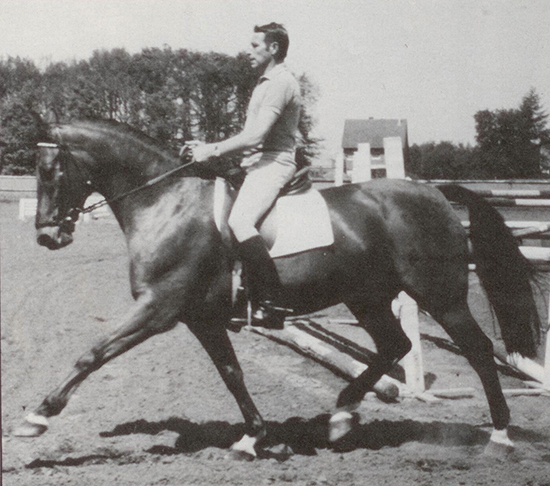
Wolfgang rides the seven year old, Troubadour, in Medium Trot, note the strength of the hind legs and the complete balance and self-carriage.
After the lesson, Wolfgang discusses the problem:
“The half halt is a difficult thing for all riders. Most of my professional riders, have the same problem. For me, the half halt is the key to riding.”
“To achieve the half halt, first you must have a good seat, correct and elastic, then you are able to work the legs, weight and hand together. We all have the tendency to hang on, with our hands too far back. The hands must be constant, in place, and we ride the horse into the hands. Break the hands, make them soft. When we come back to a collected movement, do not use one half halt and hold it for a long time, use five or six little half halts. The difficulty starts at Novice and goes all the way to Grand Prix. In all the transitions the half halt is the most important thing -and one of the most difficult things to achieve correctly.”
“The half halt is the playing together of the aids. It is such a broad thing. From the half halt that just says, ‘Be ready, something is about to happen,’ to the half halt of trot to walk, or medium trot to working trot, from passage to piaffe. It is not something that you can say – ‘This is it, exactly. Exactly five kilograms in each hand for exactly so long’.”
We have that good feeling that we work towards, but we must be prepared to differentiate from that according to the needs of the situation or the particular horse. Play together the aids and you will develop the feel… ‘Oh, a little more leg. Now that’s right.’ But light! Not one half halt, hanging on.”
“Play together the aids, then soft, then play together again. Then the horse will be come lighter and lighter. Not jammed. Not leaning. Coming lighter in front of himself.”
At the heart of all Wolfgang’s work is the horse going forward, free, relaxed, in a long outline- ready at any time to chew down on the bit when it is offered. Long and forward is the beginning of every working session, repeated after every taxing exercise in the session, and the reward at the end of every session. This is the precondition of collection.
One of the horses in the school starts his work. Long, forward, round. Wolfgang turns and beams: “See the horse feels good. Start your working session like this, and there will be no problems.”
“We need a soft, swinging horse for any purpose … then the horse will look graceful. The first step is always the rhythm, the natural rhythm. Long, a little contact, and move forward. The horses have to learn to carry the weight of the rider and balance themselves without force. Start with the loose or the long rein in the walk. Walk in an even tempo. Big, active, with everything supple. All the muscles of the horse relax, there is no stiffness. The horse is relaxed mentally and physically.”
“The warm-up is essential to build up the horse, to move oxygen to the muscles. If we go straight into flying changes or collected work, we damage the muscle fibre. No human athlete can come out of a car, put on shorts, and start doing sprints. If the sprinter doesn’t warm up properly, he hurts. Our partners cannot tell us that it hurts. The work should not start until the horse is relaxed, carries his tail, swings his back, is relaxed in the mouth and shows a contented expression. It is important to use different methods in the warming-up phase.”
“It is for instance good to start a session for a dressage horse with some gymnastic jumping. A series of little cavalettis to three jumps, bounce over the jump, bounce over the jump, one stride over the last jump. Little jumps, say sixty to seventy centimetres. Make the horse round, let him use his back.”
“The test for relaxation is always that the horse chews the reins out of the hand, but his nose should never come lower than the breastbone or he will fall on the forehand.”
“Push each horse with the seat to the hand. Develop the impulsion and thrust. Encourage the horse with a swinging seat to a soft hand, not a restricting hand.”
Always, Wolfgang is looking to the comfort and the contentment of the horse. After a good piaffe or passage he says: “Touch him, touch him now. Say it was good. It is no good to touch him later. Touch him at the moment he does it right, touch him on the neck.”
Always coming back to the same simple, gentle things: “Tomorrow, take off the double bridle, and ride him in the snaffle. I promise you he will go beautifully.”
When he shows up his series of instructional slides, Wolfgang is proud to point out that he can use slides to prove the benefit of a correct education.
Wolfgang shows a slide of a four year old, the day after he bought him:
“Look at him, he looks so poor. Now look at him, thirteen months later, his muscles are well developed, he looks so pretty and round and good. That is what a good education makes in a horse. That is what gives you a good feeling. The horse looks better. He is easy to ride. He feels better. To create something so light and soft- that’s what gives pleasure.”
With his pupils, Wolfgang is always looking to develop that sensitivity: ”When you have that good feeling, (suppleness, obedience to the aids, collection) then you can do the flying change, then it will be easy.”
But Dr Holzel knows how to push, and when to push. Working with Sue Chandler and Kab, Wolfgang is helping with the one time changes. As Kab starts to go across the diagonal, he muffs one, and Sue stops:
“No. You have a fault- go on. Don’t always stop, or he will think ‘Oh, I make a mistake and we stop.’ It doesn’t matter, do it again, repeat now, that was good, go on, go on. Sit a little more still, you cannot alter the balance, relax, let them happen.” Kabs skips gracefully across the school, throwing off a change every stride … “that was good, touch the neck, give the rein.”
Wolfgang beams and laughs, Sue laughs, and relaxes.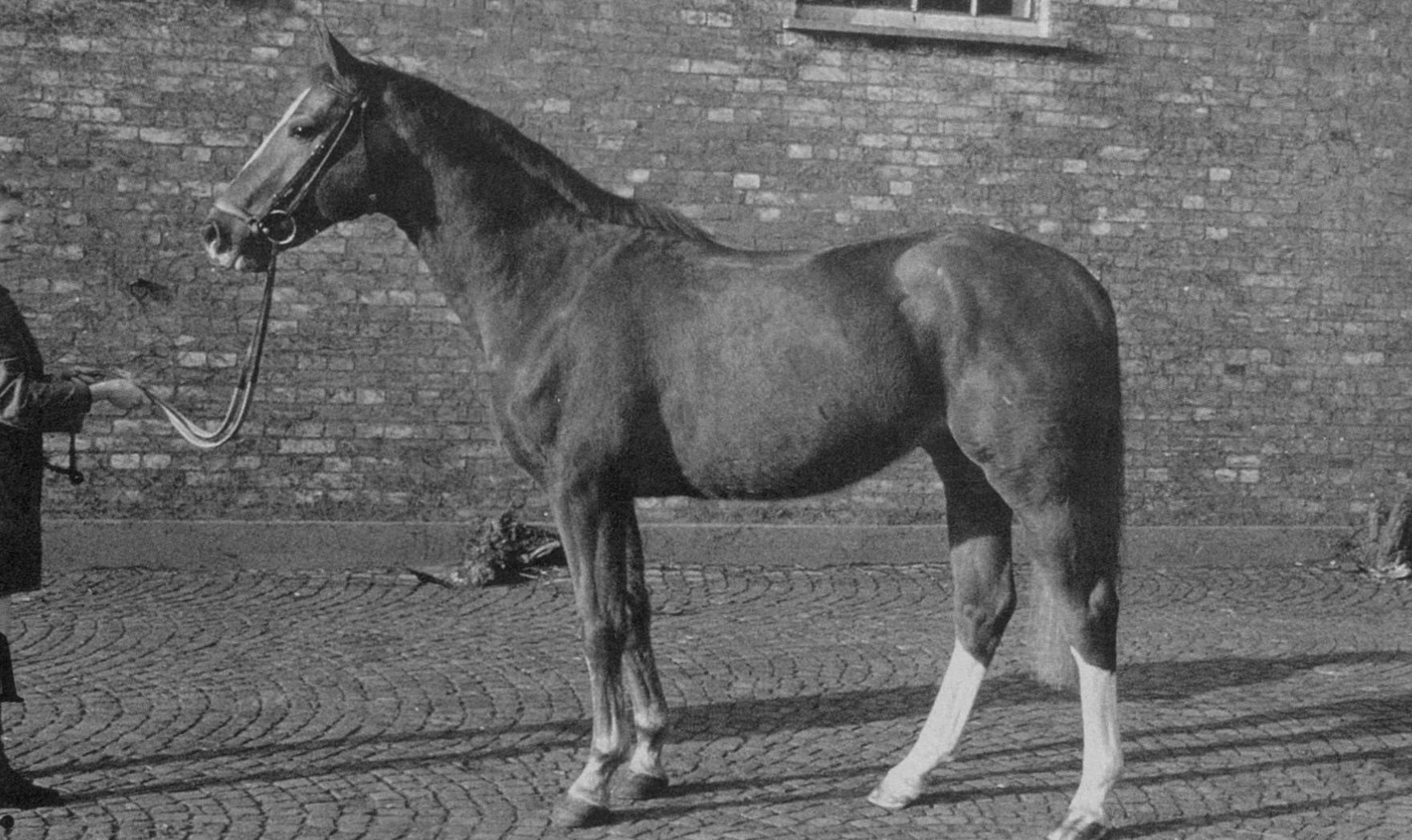
From this! – Holzel’s younger horse, then four years old, a son of Furioso (Oldenburg): looking rather poor and undeveloped.
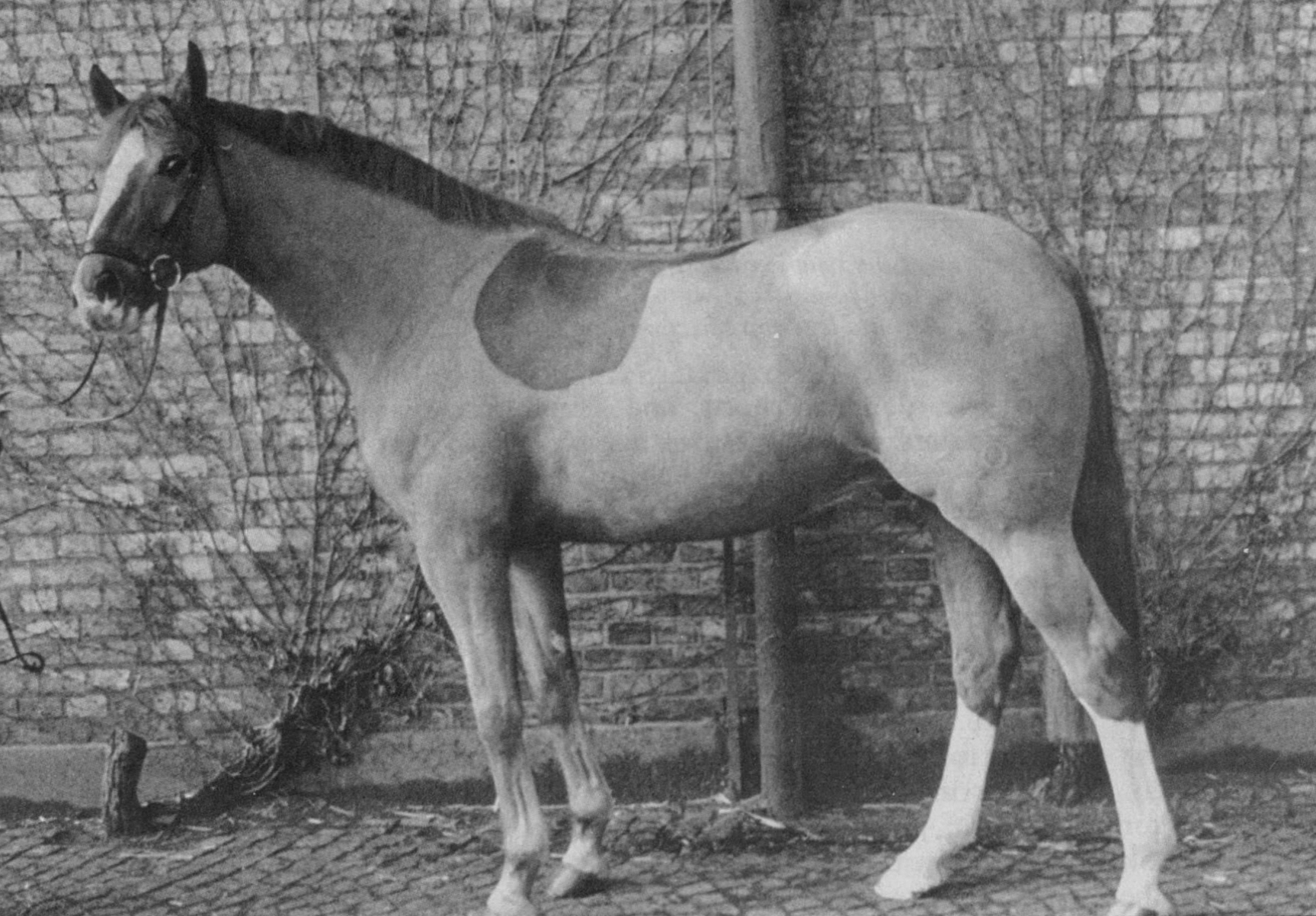
To this! – The same horse one year later: a result of good feeding, education and training.
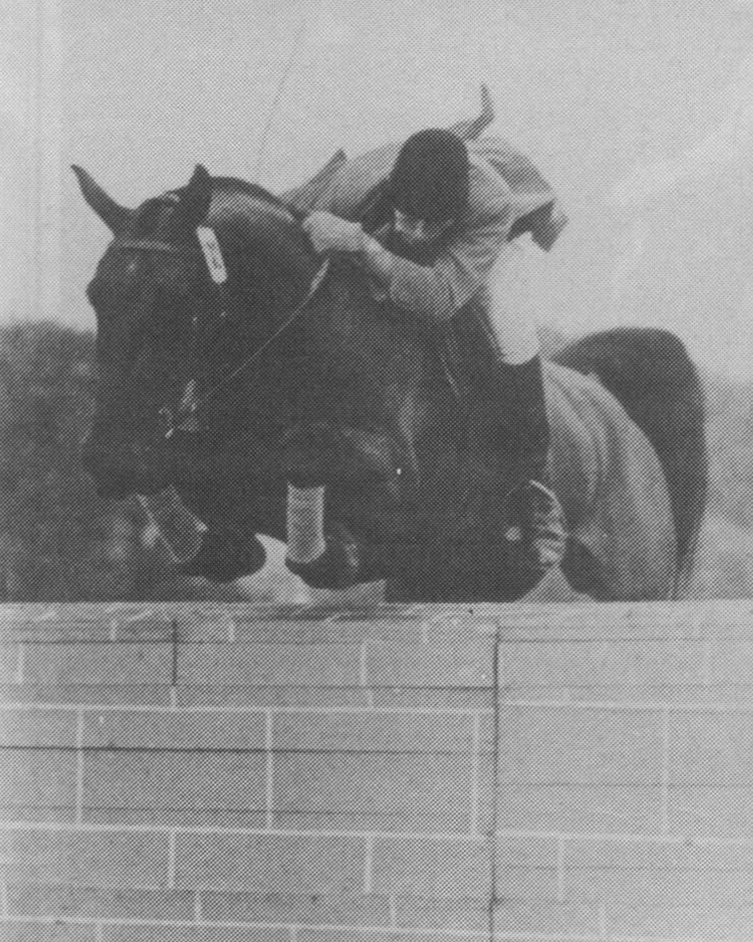
Complete confidence in the rider: After conscientious preparation for this task Heike jumps over 2.10 metres.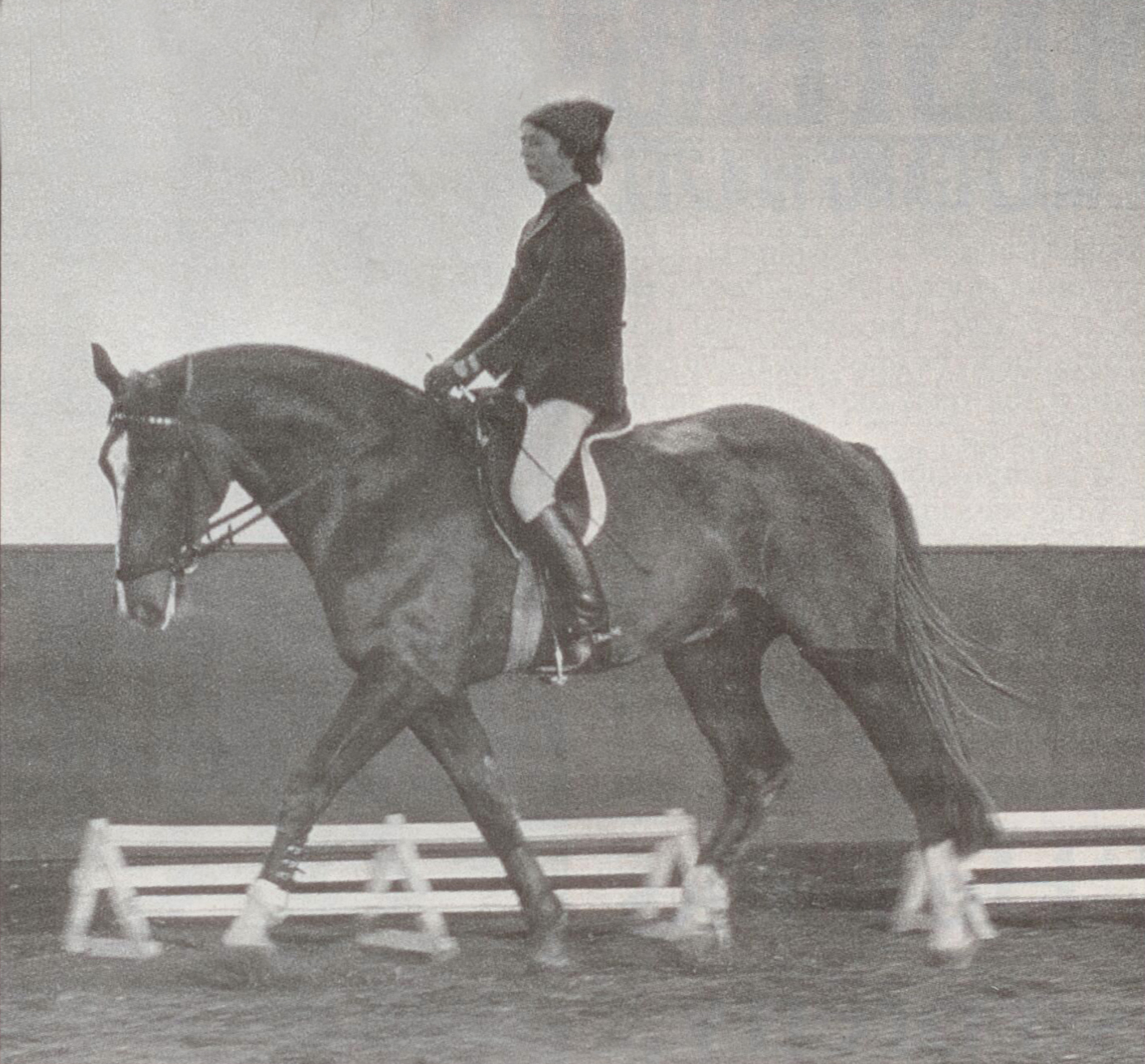
From a long outline the young horse is easily asked to go on the bit by soft half halts. Holzel’s wife with a three and a half year old of ‘Steinadler’ (Westfalen).
“Now make him round and soft in your hand. Now walk, now passage.”
Kab comes into some beautiful steps of Passage. It has all been so gradual, so progressive, there has never been a point where the horse thinks, ‘Oh, oh, now we are going to do something hard.’ The work is light and graceful, getting better every day. It is a measure of how far dressage has progressed in Australia, that at the School at Statene Park, horse after horse enters the school ready to do the more advanced movements. In the morning session, Schwarzwald and Rayner
Kramer, Kab and Sue Chandler, Man About Town and Helen Heagney … all working on one time changes, all working on piaffe, passage, pirouette.
“Every horse has his own individuality,” Wolfgang says, “You must feel, and watch and see what to apply. There are different points to watch at all times – and at each point there are special rules. Are you teaching the horse a new thing? Are we performing an exercise that the horse already knows? Are we polishing up a movement for a Test? In each instance we must approach the exercise differently.”
“If you are teaching something new and he does it correctly, then you must reward him immediately. If he does his first flying change, then stop and put him away, so that he knows exactly what you have been asking. It is important to tell the horse straight away, so he remembers why he got the reward. When the horse does something for the first time, we will not worry if it is a little rough. If he does a flying change, it doesn’t matter if he goes faster to do it, or if his expression is not graceful, he can go crooked or swing, as long as he does it, and he is listening to the aids.”
“Later, we are looking for more, we are polishing the exercise, especially for a test. In the flying change, he must jump through, with rhythm, so that the horse looks impressive. He does the change on the spot, with soft aids. We must be aware of the level at which we work, and shape the work to the level.”
“When we go to do an exercise, then we have different criteria. First the horse has to learn an exercise. Then we do the exercise to train the horse. Exercises are the only way to build a horse up. In the shoulder-in, for instance, we are building the muscles, the horse is becoming more flowing, more gymnastic.”
“Eventually we are building collection. We move the centre of gravity of the rider and the horse towards the hindquarters, through the bending of the hocks and the activity of the hips and the legs. The horse is becoming more elevated, he is giving us the feeling that he is going uphill.”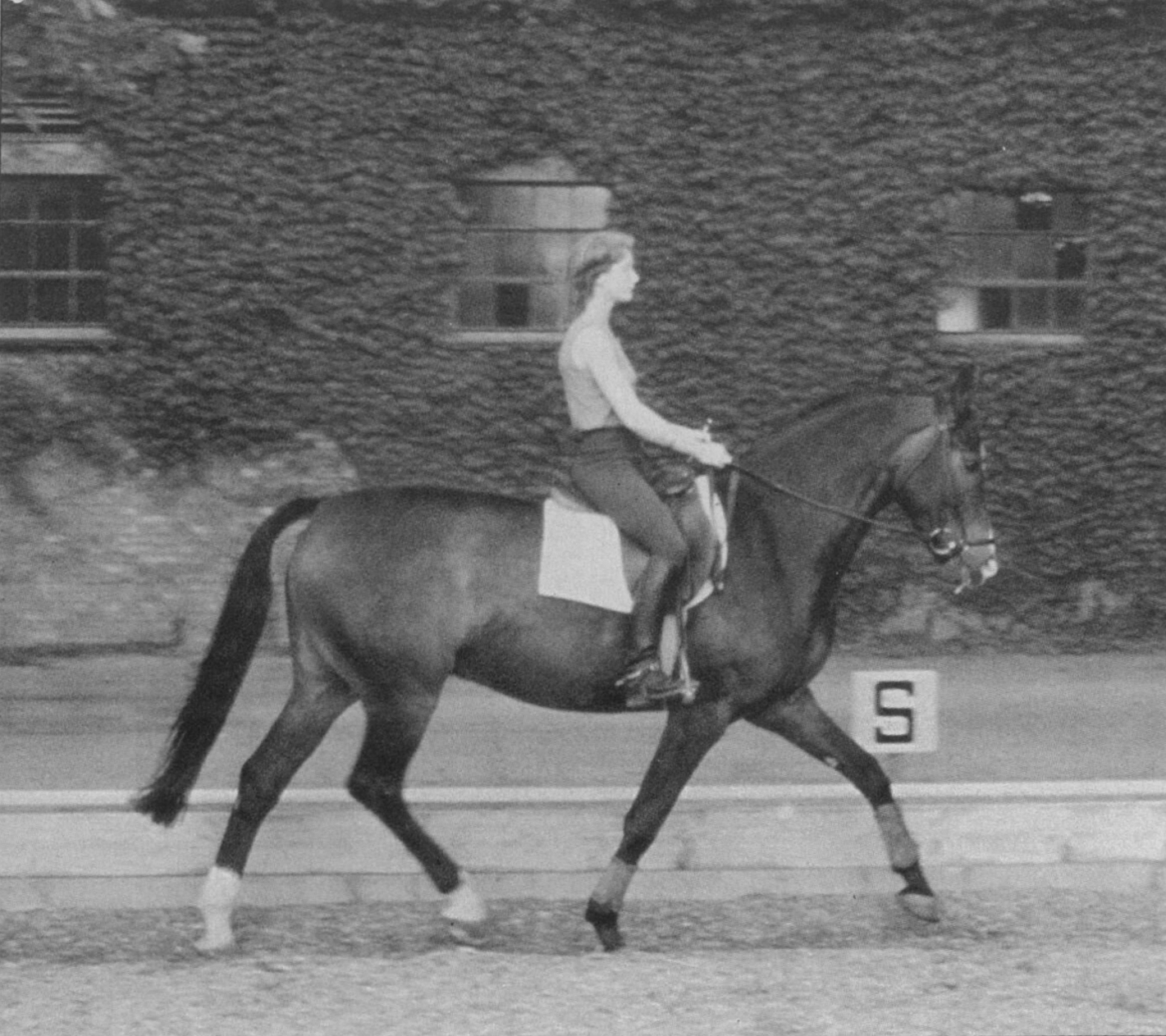
Florett, when he was four.
But no matter how advanced the horse becomes, the test of correct work remains the same:
“If you have worked your horse well, it doesn’t matter what standard you are working at, it doesn’t matter if it is a dressage horse or a showjumper, whenever you ask for the long outline he must give it to you. The horse must never become stuck, he must always be ready to chew the reins into a long outline. That is the test!”
“It is impossible to teach the horse every day the same exercise, dressage all the time. The horse needs exercise, to go forward, to run – that’s nature. And we dressage riders are all the time wanting to set them back! It’s no good to put them in a box and bring them out for half an hour’s dressage a day.”
“Go for a ride in the country now and again. Give the horse variety. Go cross country, jump a few little jumps. Not all dressage riders do this, but the top riders, like Dr Klimke, do it. My dressage horses, one day a week, I shorten the stirrups and take them outside or over some little jumps. “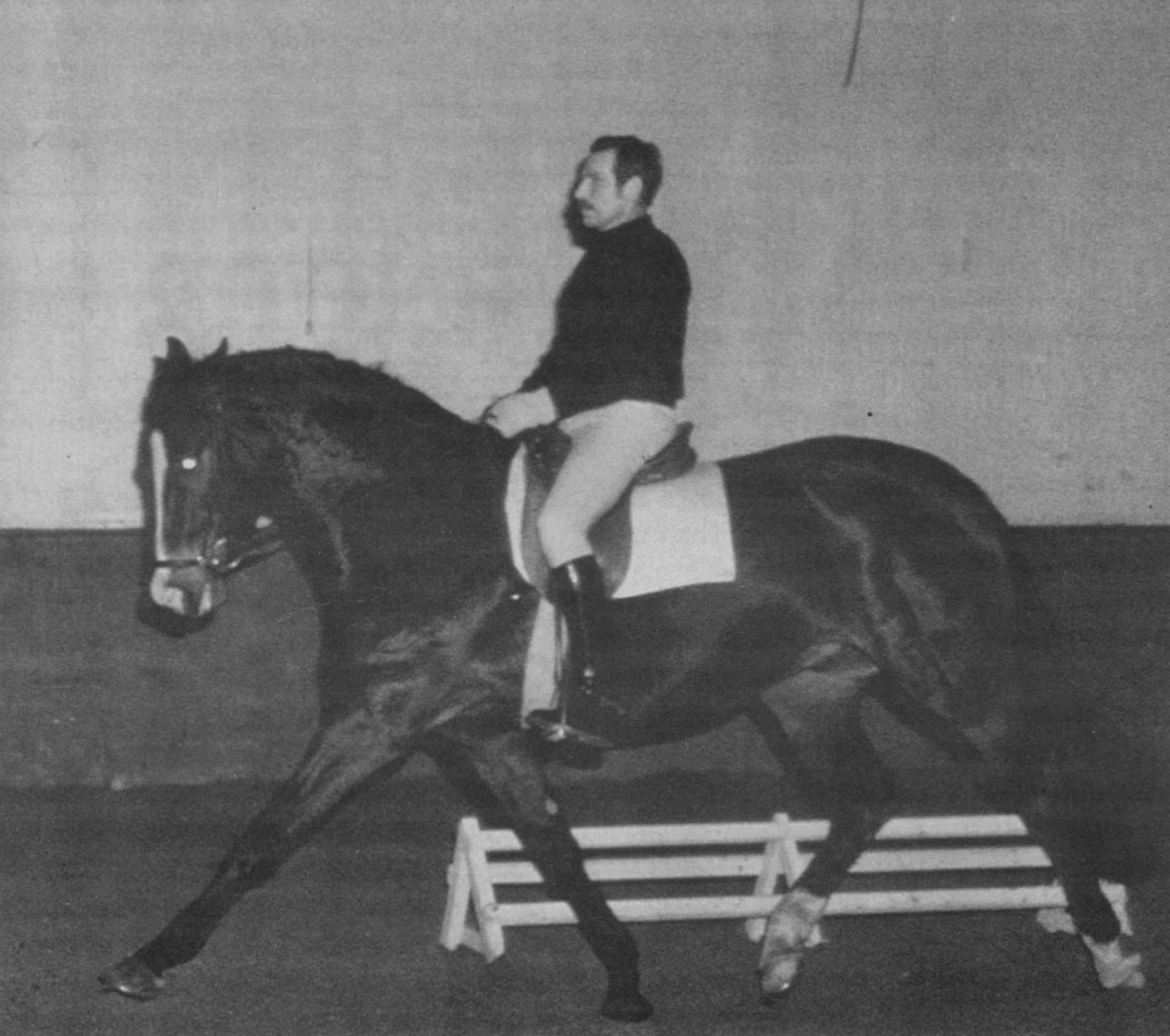
Florets at the age of five. Muscles and expression of movement have improved considerably.
With a proper sense of thoroughness, the planners of the Warendorf complex, upon realising that the area was flat, built a series of little hills along the riding track. It is the sort of touch that you can imagine Wolfgang applauding. Thorough conscientious thinking about the horses and their welfare, too.
This article first appeared in the July 1984 issue of THM.


Lovely article about a true horseman and as you say didn’t get to spend enough time with the Aussies
I was so lucky to be on the Squad under Dr. Holzel